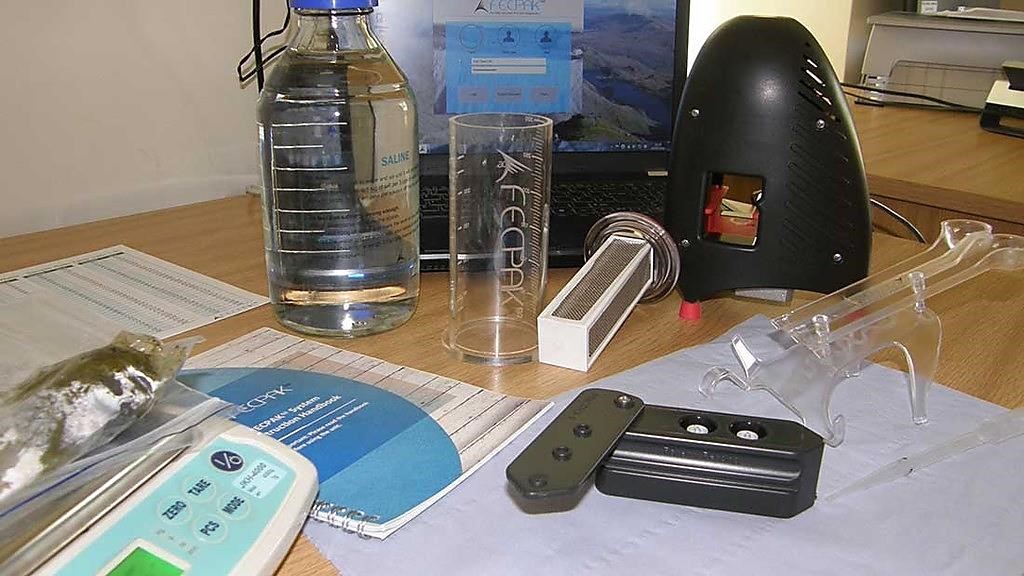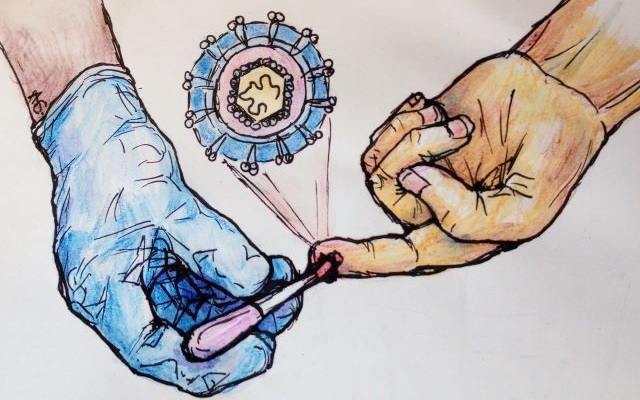Methods Compared Classifying Intensity of Soil-Transmitted Helminth Infections
|
By LabMedica International staff writers Posted on 23 Jul 2020 |

Image: The FECPAKG2 is an internet connected, image based diagnostic platform scientifically validated to conduct fecal egg count (FEC) tests (Photo courtesy of Techion).
Soil-transmitted helminths (Ascaris lumbricoides, Trichuris trichiura) and the hookworms, Necator americanus and Ancylostoma duodenale affect one quarter of the world population, and are responsible for the loss of more than three million disability-adjusted life years (DALYs).
There are a variety of novel microscopy and DNA-based methods to identify soil-transmitted helminths, but it remains unclear whether applying current World Health Organization (WHO) thresholds on to these methods allows for a reliable classification of moderate-to-heavy intensity (M&HI) infections.
An international team of scientists led by those at Ghent University (Merelbeke, Belgium) defined method-specific thresholds and verified whether they increased the correct classification of M&HI infections in a multi-countries study. They evaluated both WHO and method-specific thresholds for classifying the M&HI infections for novel microscopic methods: McMaster egg counting technique, FECPAKG2 (Techion, Aberystwyth, UK), and Mini-FLOTAC (Federico II University of Naples, Naples, Italy) and DNA-based (qPCR) diagnostic methods (Elisabeth-Tweesteden Hospital, Tilburg, The Netherlands). The samples were also analyzed by Kato-Katz method as the reference method.
The team applied the WHO thresholds, the new microscopic methods mainly misclassified M&HI as low intensity, and to a lesser extent low intensity infection as M&HI. For FECPAKG2, applying the method-specific thresholds significantly improved the agreement for Ascaris (moderate → substantial), Trichuris and hookworms (fair → moderate). For Mini-FLOTAC, a significantly improved agreement was observed for hookworms only (fair → moderate). For the other STHs, the agreement was almost perfect and remained unchanged. For McMaster, the method-specific thresholds revealed a fair to a substantial agreement, but did not significantly improve the agreement. For qPCR, the method-specific thresholds based on genome equivalents per mL of DNA moderately agreed with the reference method for hookworms and Trichuris infections. For Ascaris, there was a substantial agreement.
The authors concluded that their results indicated that method-specific thresholds improved the classification of M&HI infections, but they stressed that validation studies are required before they can be recommended for general use in assessing M&HI infections in programmatic settings. The study also highlights the need (i) to agree on an absolute universal unit for qPCR, (ii) to align the evaluation of diagnostic methods with current STH program goals, and (iii) to define minimal and ideal (optimistic) criteria that diagnostic methods should meet in order to assess M&HI infections reliably. The study was published on July 2, 2020 in the journal PLOS Neglected Tropical Diseases.
Related Links:
Ghent University
Techion
Federico II University of Naples
Elisabeth-Tweesteden Hospital
There are a variety of novel microscopy and DNA-based methods to identify soil-transmitted helminths, but it remains unclear whether applying current World Health Organization (WHO) thresholds on to these methods allows for a reliable classification of moderate-to-heavy intensity (M&HI) infections.
An international team of scientists led by those at Ghent University (Merelbeke, Belgium) defined method-specific thresholds and verified whether they increased the correct classification of M&HI infections in a multi-countries study. They evaluated both WHO and method-specific thresholds for classifying the M&HI infections for novel microscopic methods: McMaster egg counting technique, FECPAKG2 (Techion, Aberystwyth, UK), and Mini-FLOTAC (Federico II University of Naples, Naples, Italy) and DNA-based (qPCR) diagnostic methods (Elisabeth-Tweesteden Hospital, Tilburg, The Netherlands). The samples were also analyzed by Kato-Katz method as the reference method.
The team applied the WHO thresholds, the new microscopic methods mainly misclassified M&HI as low intensity, and to a lesser extent low intensity infection as M&HI. For FECPAKG2, applying the method-specific thresholds significantly improved the agreement for Ascaris (moderate → substantial), Trichuris and hookworms (fair → moderate). For Mini-FLOTAC, a significantly improved agreement was observed for hookworms only (fair → moderate). For the other STHs, the agreement was almost perfect and remained unchanged. For McMaster, the method-specific thresholds revealed a fair to a substantial agreement, but did not significantly improve the agreement. For qPCR, the method-specific thresholds based on genome equivalents per mL of DNA moderately agreed with the reference method for hookworms and Trichuris infections. For Ascaris, there was a substantial agreement.
The authors concluded that their results indicated that method-specific thresholds improved the classification of M&HI infections, but they stressed that validation studies are required before they can be recommended for general use in assessing M&HI infections in programmatic settings. The study also highlights the need (i) to agree on an absolute universal unit for qPCR, (ii) to align the evaluation of diagnostic methods with current STH program goals, and (iii) to define minimal and ideal (optimistic) criteria that diagnostic methods should meet in order to assess M&HI infections reliably. The study was published on July 2, 2020 in the journal PLOS Neglected Tropical Diseases.
Related Links:
Ghent University
Techion
Federico II University of Naples
Elisabeth-Tweesteden Hospital
Latest Technology News
- Pioneering Blood Test Detects Lung Cancer Using Infrared Imaging
- AI Predicts Colorectal Cancer Survival Using Clinical and Molecular Features
- Diagnostic Chip Monitors Chemotherapy Effectiveness for Brain Cancer
- Machine Learning Models Diagnose ALS Earlier Through Blood Biomarkers
- Artificial Intelligence Model Could Accelerate Rare Disease Diagnosis
- AI Saliva Sensor Enables Early Detection of Head and Neck Cancer
- AI-Powered Biosensor Technology to Enable Breath Test for Lung Cancer Detection
- AI Model Achieves Breakthrough Accuracy in Ovarian Cancer Detection
- Portable Biosensor Diagnoses Psychiatric Disorders Using Saliva Samples
- Cell-Sorting Device Uses Electromagnetic Levitation to Precisely Direct Cell Movement

- Embedded GPU Platform Enables Rapid Blood Profiling for POC Diagnostics
Channels
Clinical Chemistry
view channel
Blood Test Could Predict and Identify Early Relapses in Myeloma Patients
Multiple myeloma is an incurable cancer of the bone marrow, and while many patients now live for more than a decade after diagnosis, a significant proportion relapse much earlier with poor outcomes.... Read more
Compact Raman Imaging System Detects Subtle Tumor Signals
Accurate cancer diagnosis often depends on labor-intensive tissue staining and expert pathological review, which can delay results and limit access to rapid screening. These conventional methods also make... Read moreMolecular Diagnostics
view channel
Blood Test Combined with MRI Brain Scans Reveals Two Distinct Multiple Sclerosis Types
Multiple sclerosis (MS) affects more than 2.8 million people worldwide, yet predicting how the disease will progress in individual patients remains difficult. Current MS classifications are based on clinical... Read more
Ultra-Sensitive Blood Biomarkers Enable Population-Scale Insights into Alzheimer’s Pathology
Accurately estimating how many people carry Alzheimer’s disease pathology has long been a challenge, as traditional methods rely on small, clinic-based samples rather than the general population.... Read more
Blood Test Could Predict Death Risk in World’s Most Common Inherited Heart Disease
Hypertrophic cardiomyopathy (HCM) is the world’s most common inherited heart condition and affects millions of people globally. While some patients live with few or no symptoms, others develop heart failure,... Read moreHematology
view channel
MRD Tests Could Predict Survival in Leukemia Patients
Acute myeloid leukemia is an aggressive blood cancer that disrupts normal blood cell production and often relapses even after intensive treatment. Clinicians currently lack early, reliable markers to predict... Read more
Platelet Activity Blood Test in Middle Age Could Identify Early Alzheimer’s Risk
Early detection of Alzheimer’s disease remains one of the biggest unmet needs in neurology, particularly because the biological changes underlying the disorder begin decades before memory symptoms appear.... Read more
Microvesicles Measurement Could Detect Vascular Injury in Sickle Cell Disease Patients
Assessing disease severity in sickle cell disease (SCD) remains challenging, especially when trying to predict hemolysis, vascular injury, and risk of complications such as vaso-occlusive crises.... Read more
ADLM’s New Coagulation Testing Guidance to Improve Care for Patients on Blood Thinners
Direct oral anticoagulants (DOACs) are one of the most common types of blood thinners. Patients take them to prevent a host of complications that could arise from blood clotting, including stroke, deep... Read moreImmunology
view channel
Ultrasensitive Liquid Biopsy Demonstrates Efficacy in Predicting Immunotherapy Response
Immunotherapy has transformed cancer treatment, but only a small proportion of patients experience lasting benefit, with response rates often remaining between 10% and 20%. Clinicians currently lack reliable... Read more
Blood Test Could Identify Colon Cancer Patients to Benefit from NSAIDs
Colon cancer remains a major cause of cancer-related illness, with many patients facing relapse even after surgery and chemotherapy. Up to 40% of people with stage III disease experience recurrence, highlighting... Read morePathology
view channel
Genetics and AI Improve Diagnosis of Aortic Stenosis
Aortic stenosis is a progressive narrowing of the aortic valve that restricts blood flow from the heart and can be fatal if left untreated. There are currently no medical therapies that can prevent or... Read more
AI Tool Simultaneously Identifies Genetic Mutations and Disease Type
Interpreting genetic test results remains a major challenge in modern medicine, particularly for rare and complex diseases. While existing tools can indicate whether a genetic mutation is harmful, they... Read more
Rapid Low-Cost Tests Can Prevent Child Deaths from Contaminated Medicinal Syrups
Medicinal syrups contaminated with toxic chemicals have caused the deaths of hundreds of children worldwide, exposing a critical gap in how these products are tested before reaching patients.... Read more
Tumor Signals in Saliva and Blood Enable Non-Invasive Monitoring of Head and Neck Cancer
Head and neck cancers are among the most aggressive malignancies worldwide, with nearly 900,000 new cases diagnosed each year. Monitoring these cancers for recurrence or relapse typically relies on tissue... Read moreTechnology
view channel
Pioneering Blood Test Detects Lung Cancer Using Infrared Imaging
Detecting cancer early and tracking how it responds to treatment remains a major challenge, particularly when cancer cells are present in extremely low numbers in the bloodstream. Circulating tumor cells... Read more
AI Predicts Colorectal Cancer Survival Using Clinical and Molecular Features
Colorectal cancer is one of the most common and deadly cancers worldwide, and accurately predicting patient survival remains a major clinical challenge. Traditional prognostic tools often rely on either... Read moreIndustry
view channel
BD and Penn Institute Collaborate to Advance Immunotherapy through Flow Cytometry
BD (Becton, Dickinson and Company, Franklin Lakes, NJ, USA) has entered into a strategic collaboration with the Institute for Immunology and Immune Health (I3H, Philadelphia, PA, USA) at the University... Read more


















